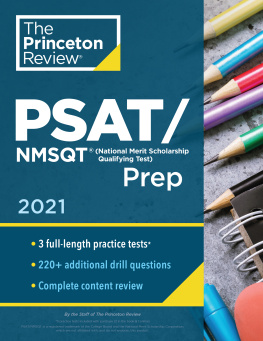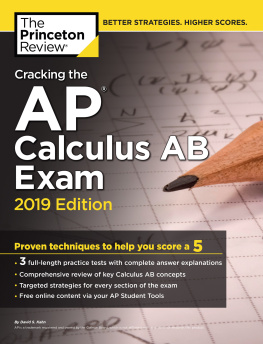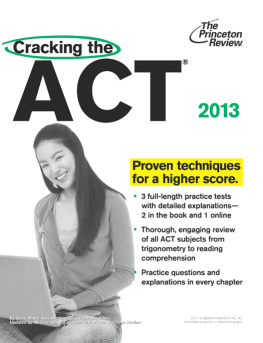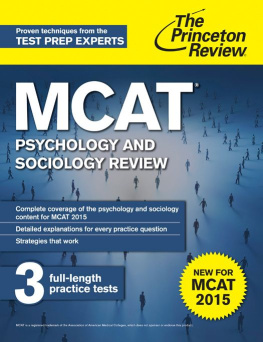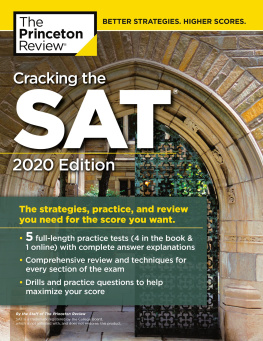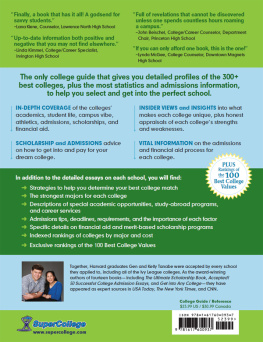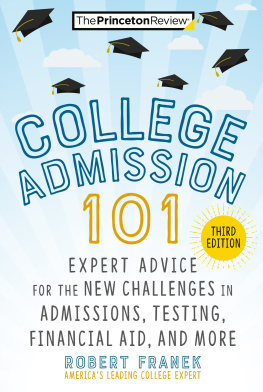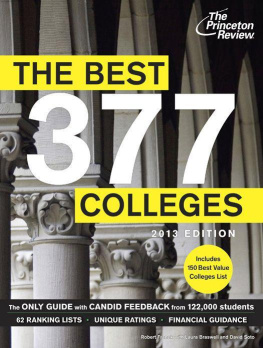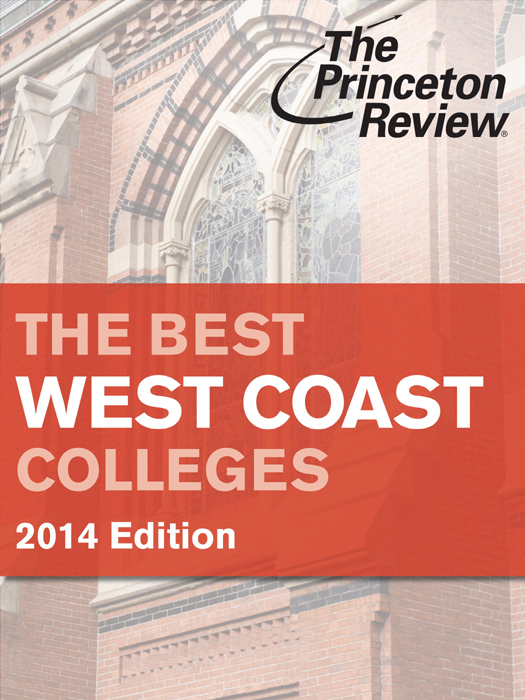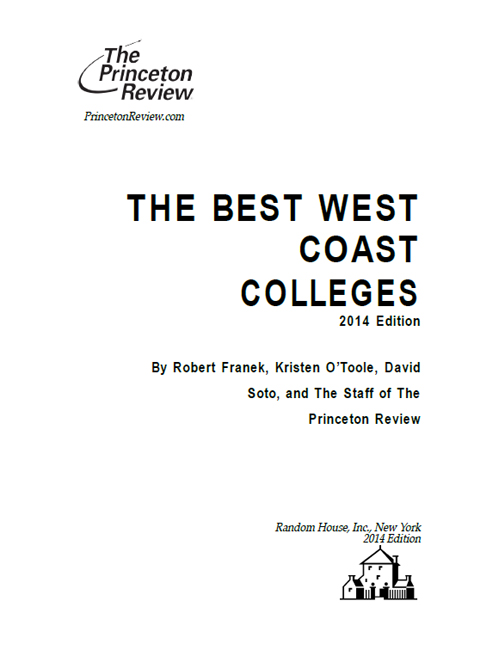TPR Education IP Holdings, LLC
111 Speen Street, Suite 550
Framingham, MA 01701
E-mail:
2013 by TPR Education IP Holdings, LLC
All rights reserved under International and Pan-American Copyright Conventions. Published in the United States by Random House LLC, New York, and simultaneously in Canada by Random House of Canada Limited, Toronto.
A Penguin Random House Company
The material in this book also appears in different form in The Best 378 Colleges, published as a trade paperback by Random House in 2013.
All rankings, ratings, and listings are intellectual property of The Princeton Review, Inc. No rankings, ratings, listings, or other proprietary information in this book may be repurposed, abridged, excerpted, combined with other data, or altered for reproduction in any way without express permission of The Princeton Review.
The Princeton Review is not affiliated with Princeton University.
eBook ISBN: 978-0-8041-2461-4
Senior VPPublisher: Robert Franek
Editor: Kristen OToole
Production Editor: Lee Elder
Content Director: David Soto
Student Survey Manager: Stephen Koch
2014 Edition
v3.1
Contents
How and Why We Produce Our Best Colleges Guides
The 79 school profiles that appear in The Best West Coast Colleges come from our annual guide, The Best 378 Colleges. To determine which schools will be in each edition, we dont use mathematical calculations or formulas. Instead we rely on a wide range of input, both quantitative and qualitative. Every year we collect data from more than 2,000 colleges that we use for The Best 378 Colleges, The Complete Book of Colleges, The Best Value Colleges, and our web-based profiles of schools. We visit dozens of colleges and meet with their admissions officers, deans, presidents, and college students. We talk with hundreds of high school counselors, parents, and students. Colleges also submit information to us requesting consideration for inclusion in the book. As a result, we are able to maintain a constantly evolving list of colleges to consider adding to the book. Any college we add to the guide, however, must agree to support our efforts to survey its students via our anonymous student survey. (Sometimes a colleges administrative protocols will not allow it to participate in our student survey; this has caused some academically outstanding schools to be absent from the guide.) Finally, we work to ensure that our roster of colleges presents a wide representation of institutions by character and type. Here youll find profiles of public and private schools, mens and womens colleges, nontraditional colleges, highly selective schools, and some with virtually open-door admissions policies. With support from nearly a million students whove participated in our student surveys over the years, and administrators at nearly 400 colleges, were pleased to offer what we continue to believe is the most substantive resource you can find to know which of these 79 schools may be best for you.
Note: Please be aware that were using the term coast rather loosely; this book contains profiles of schools throughout the western United States, including schools in Arizona, Colorado, Hawaii, Idaho, Kansas, Montana, New Mexico, Nevada, Oklahoma, Texas, Utah, and Wyoming, as well as in California, Oregon, and Washington.
About Our Student Survey for Our Best Colleges Books
Surveying tens of thousands of students on hundreds of campuses is a mammoth undertaking. In 1992, our survey was a paper survey. We worked with school administrators to set up tables in centrally-trafficked locations on their campuses at which students filled out the surveys. To reach a range of students, freshmen to seniors, this process sometimes took place over several days and at various on-campus locations. That process yielded about 125 surveys per college.
However, the launch of our online survey several years ago made our survey process more efficient, secure, and representative. Our student survey is also now a continuous process. Students submit surveys online from all schools in the book and they can submit their surveys at any time at http://survey.review.com. (However, our site will accept only one survey from a student per academic year per school (its not possible to stuff the ballot box, as it were)). In addition to those surveys we receive from students on an ongoing basis, we also conduct formal surveys of students at each school in the book at least once every three years. (We conduct these more often once every three years if the colleges request that we do so (and we can accommodate that request) or we deem it necessary.)
How do we do conduct those formal surveys? First, we notify our administrative contacts at the schools we plan to survey. We depend upon these contacts for assistance in informing the student body of our survey (although we also get the word out to students about our survey via other channels independent of the schools). An increasing number of schools have chosen to send an e-mail to the entire student body about the availability of our online survey; in such cases this has yielded robust response rates. Our average number of student surveys (per college) is now 333 students per campus (and at some schools we hear from more than 3,000 students).
And of course, surveys we receive from students outside of their schools normal survey cycles are always factored into the subsequent years ranking calculations, so our pool of student survey data is continuously refreshed.
The survey has more than eighty questions divided into four sections: About Yourself, Your Schools Academics/Administration, Students, and Life at Your School. We ask about all sorts of things, from How many out-of-class hours do you spend studying each day? to How do you rate your campus food? Most questions offer students a five-point grid on which to indicate their answer choices (headers may range from Excellent to Awful). Eight questions offer students the opportunity to expand on their answers with narrative comment. These essay-type responses are the sources of the student quotations that appear in the school profiles. Once the surveys have been completed and responses stored in our database, every college is given a score (similar to a grade point average) for its students answers to each question. This score enables us to compare students responses to a particular question from one college to the next. We use these scores as an underlying data point in our calculation of the ratings in the profile data sections.
Once we have the student survey information in hand, we write the college profiles. Student quotations in each profile are chosen because they represent the sentiments expressed by the majority of survey respondents from the college; or, they illustrate one side or another of a mixed bag of student opinion, in which case there will also appear a counterpoint within the text. In order to guard against producing a write-up thats off the mark for any particular college, we send our administrative contact at each school a copy of the profile we intend to publish prior to its publication date, with ample opportunity to respond with corrections, comments, and/or outright objections. In every case in which we receive requests for changes, we take careful measures to review the schools suggestions against the student survey data we collected and make appropriate changes when warranted.


